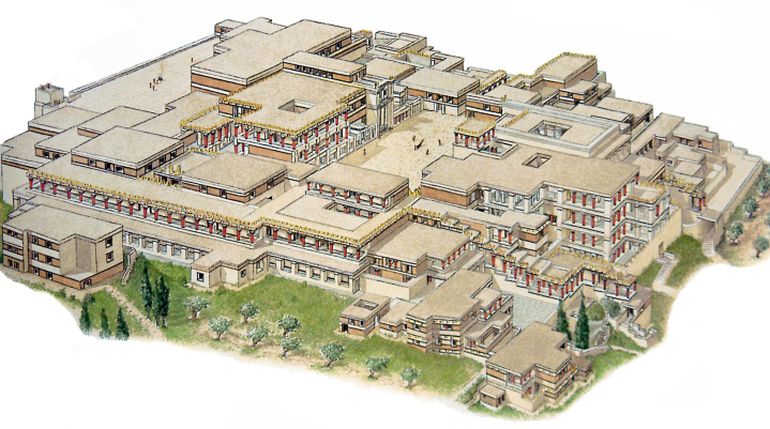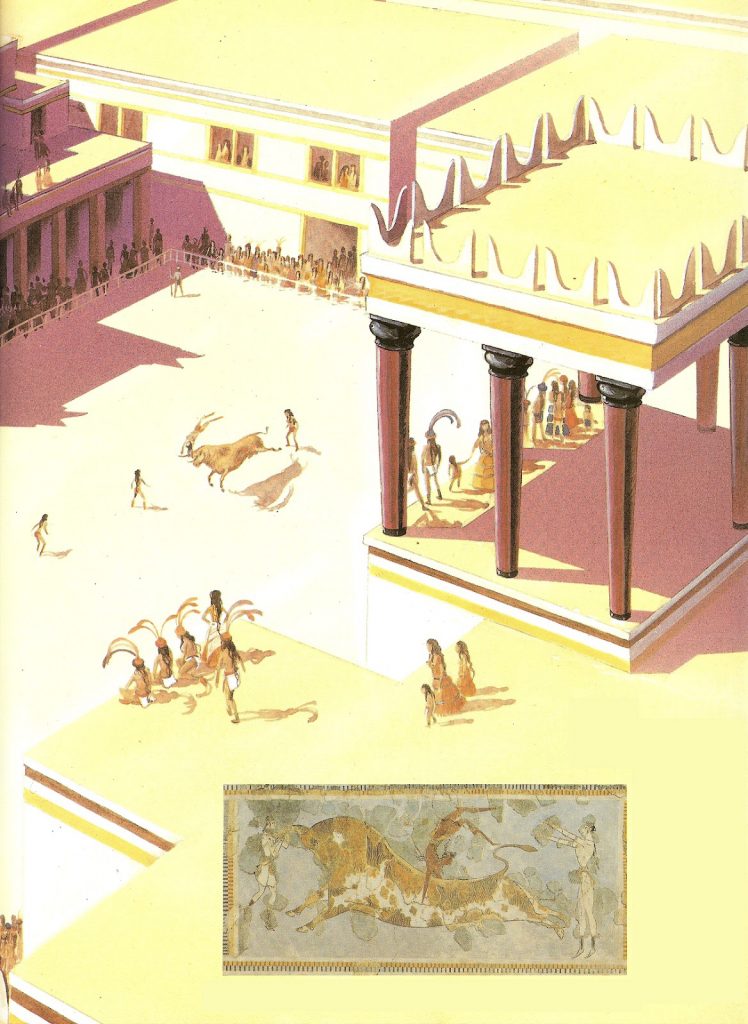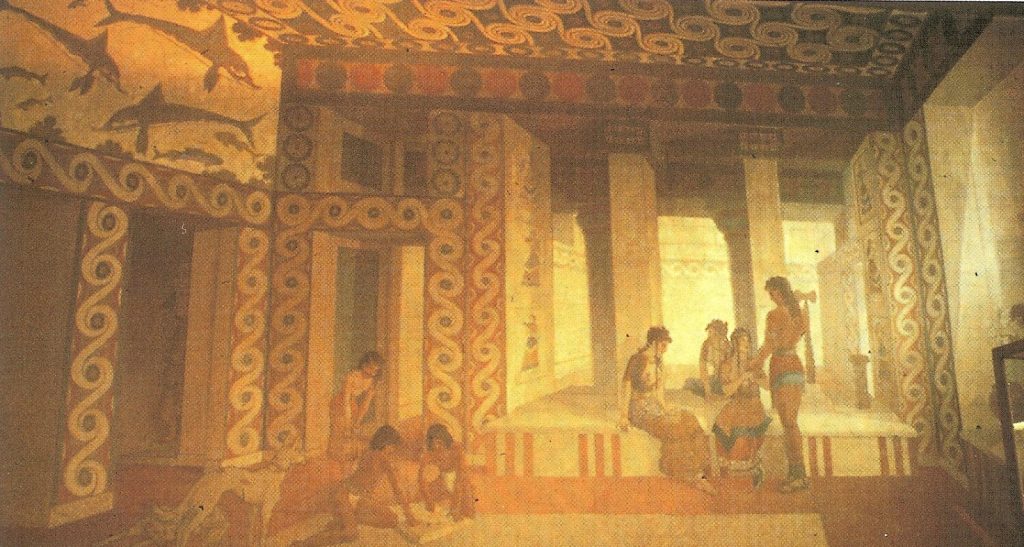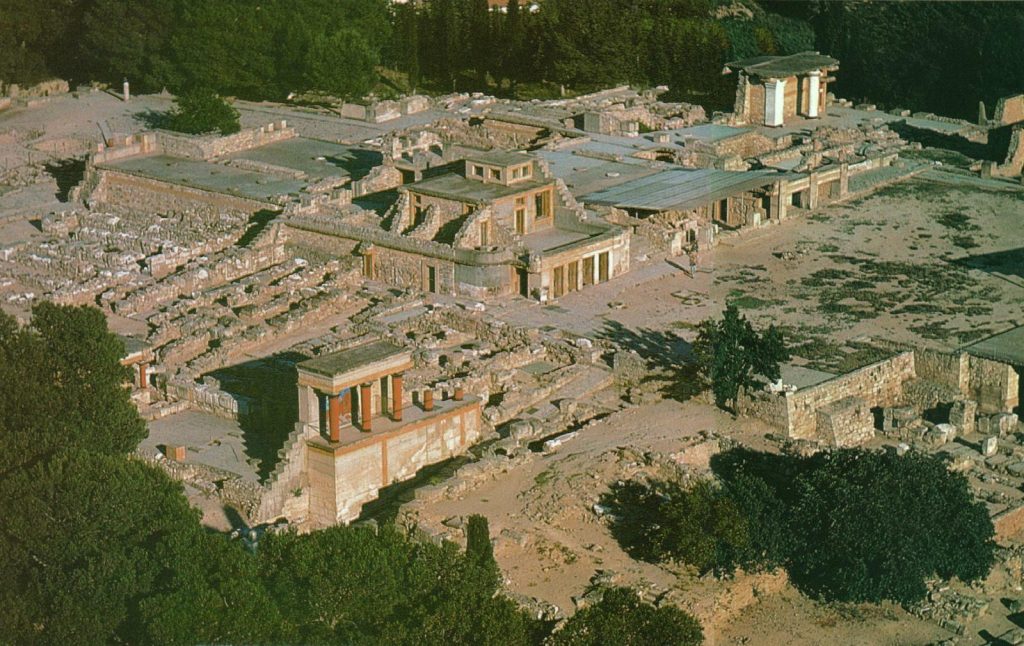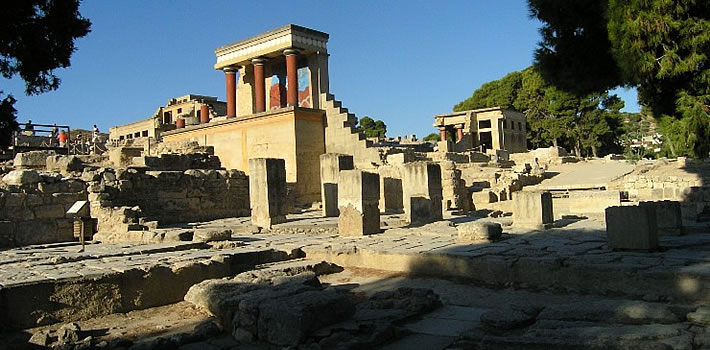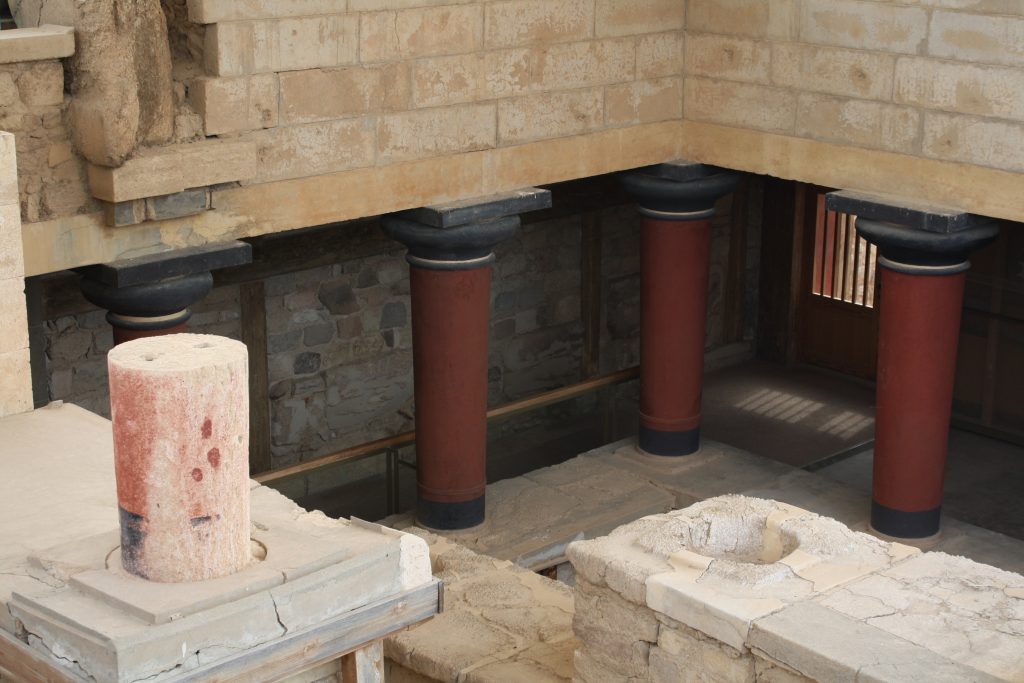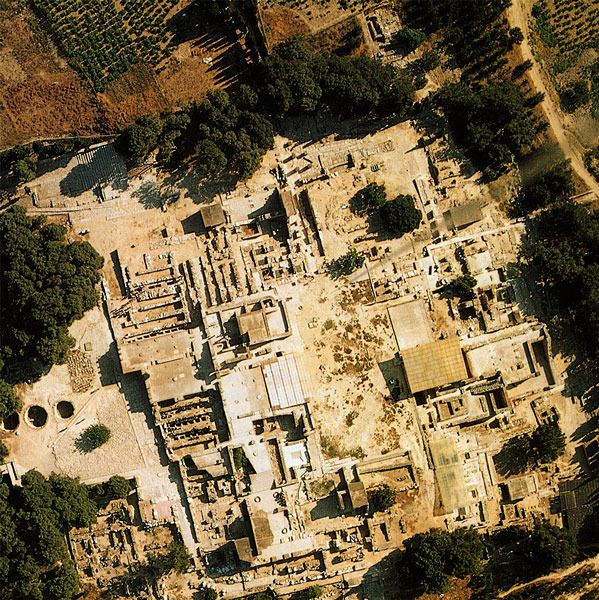The features of the palace depend on the time period. Currently visible is an accumulation of features over several centuries, the latest most dominant. Thus, the palace was never exactly as depicted today. In addition, it has been reconstituted in modern materials. The custom began in an effort to preserve the site from decay and torrential winter rain. After 1922, the chief proprietor, Arthur Evans, intended to recreate a facsimile based on archaeological evidence. The palace is not exactly as it ever was, perhaps in places, not even close, and yet in general, judging from the work put in and the care taken, as well as parallels with other palaces, it probably is a good general facsimile. Opinions range, however, from most skeptical, viewing the palace as pure fantasy based on 1920s architecture and art deco, to most unquestioning, accepting the final judgements of Arthur Evans as most accurate. The mainstream of opinion falls between.
Las características del palacio dependen de su construcción a lo largo del tiempo. Actualmente es una acumulación de varios siglos, la cual, la última es la más dominante. Por lo tanto, el palacio nunca fue exactamente como se puede ver hoy en día. Además, se ha reconstituido con materiales modernos. Esto comenzó por preservar el lugar de la escorrentía provocada por las lluvias torrenciales del invierno. Después de 1922, el propietario principal, Arthur Evans, tenía la intención de recrear un facsímil basado en la evidencia arqueológica.
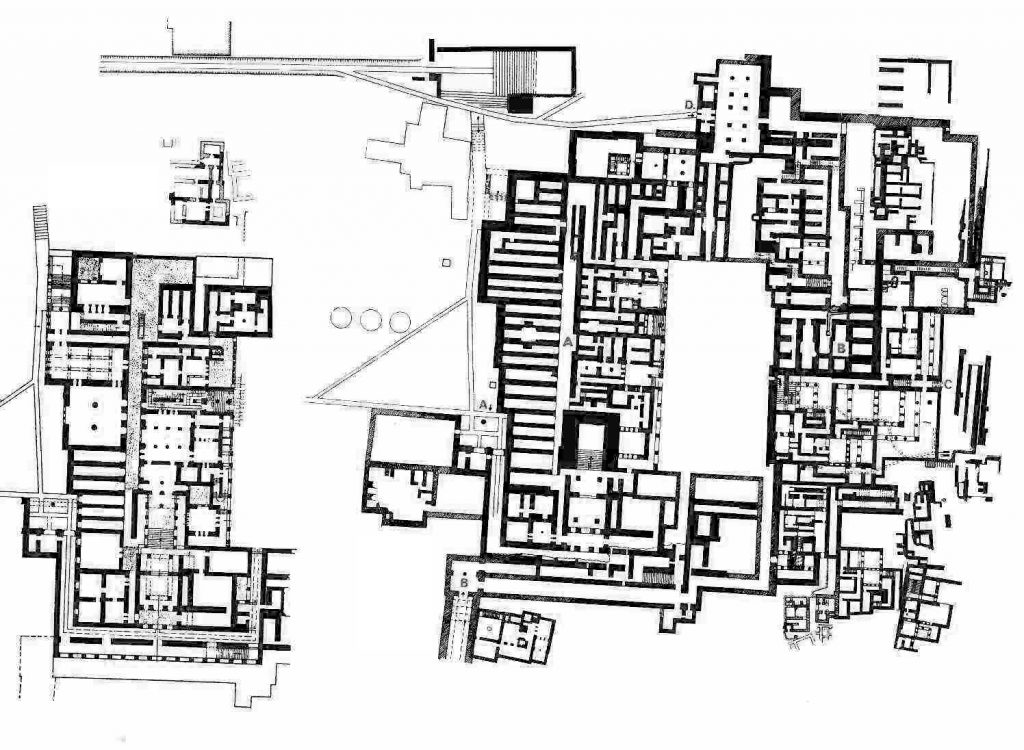
LOCATION / LOCALIZACION
From an archaeological point of view, the terms “Knossos” and “palace” are somewhat ambiguous. The palace was never just the residence of a monarch, although it contained rooms that might have been suitable for a royal family. Most of the structures, however, were designed to serve a civic, religious, and economic center. The term palace complex is more accurate. In ancient times, Knossos was a town surrounding and including the Kephala. This hill was never an acropolis in the Greek sense. It had no steep heights, remained unfortified, and was not very high off the surrounding ground. These circumstances cannot necessarily be imputed to other Minoan palaces. Phaistos, contemporaneous with Knossos, was placed on a steep ridge, controlling access to the Messara Plain from the sea, and was walled.[39] To what degree Minoan civilization might be considered warlike remains debatable. It can, however, be said that Knossos bore no resemblance to a Mycenaean citadel, whether before or during Mycenaean Greek occupation.
Desde un punto de vista arqueológico, los términos “Knossos” y “palacio” son algo ambiguos. El palacio nunca fue únicamente la residencia de un monarca, aunque contenía habitaciones que podrían haber sido adecuadas para una familia real. La mayoría de las estructuras, sin embargo, fueron diseñadas para servir a un centro cívico, religioso y económico. El término “complejo palaciego” es más exacto. En la antigüedad, Knossos era una ciudad que rodeaba e incluía a Kephala. Esta colina nunca fue una acrópolis en el sentido griego. No tenía alturas empinadas y permaneció sin fortifica. Estas circunstancias no pueden necesariamente imputarse a otros palacios minoicos. Phaistos, contemporáneo de Knossos, fue colocado en una cresta empinada, controlando el acceso a la llanura de Messara desde el mar, y fue amurallado. Hasta qué punto la civilización minoica podría considerarse guerrera sigue siendo discutible. Sin embargo, se puede decir que Knossos no se parecía en nada a una ciudadela micénica, ni antes ni durante la ocupación griega micénica.
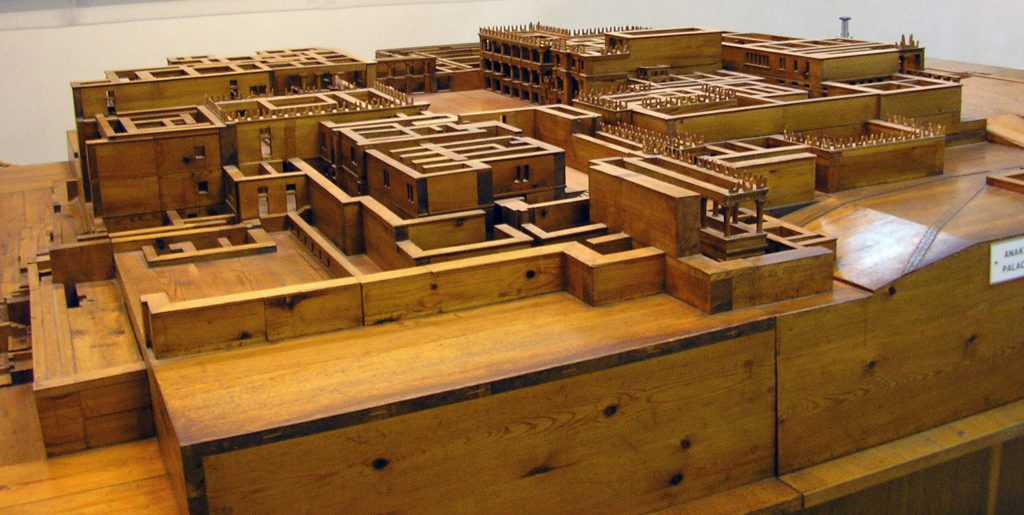
The complex was constructed ultimately around a raised central court on the top of Kephala. The previous structures were razed and the top was made level to make way for the court. The court is oblong, with the long axis, which points north-northeast, generally described as pointing “north”. Plot plans typically show the court with the long axis horizontal, apparently east-west with the north on the right, or vertical with the north on the top. Either arrangement is confusing unless the compass points are carefully marked. About 5 km (3.1 mi) to the north of the palace complex is the sea at the Port of Heraklion. Directly to the south is Vlychia Stream, an east-west tributary of the north-south Kairatos. Kephala is an isolated hill at the confluence.
El complejo se construyó finalmente alrededor de un patio central elevado en la cima de Kephala. Las estructuras anteriores fueron arrasadas y la parte superior se niveló para dar paso a la plaza. El patio es oblongo, con el eje largo, que apunta al norte-noreste, generalmente descrito como apuntando al “norte”. Los planos de la trama suelen mostrar la plaza con el eje largo horizontal, aparentemente de este a oeste con el norte a la derecha, o vertical con el norte en la parte superior. Cualquiera de los arreglos es confuso a menos que los puntos de la brújula estén marcados cuidadosamente. A unos 5 km (3,1 millas) al norte del complejo del palacio se encuentra el mar en el puerto de Heraklion. Directamente al sur está Vlychia Stream, un afluente de este a oeste del Kairatos de norte a sur. Kephala es una colina aislada en la confluencia.
The Kairatos River reaches the sea between the modern port of Heraklion and Heraklion Airport to the east. In ancient times the flow continued without interruption. Today the stream loses itself in the sewers of Heraklion before emerging from under a highway on the shore east of the port. It flows down from higher ground at Arkhanes to the south, where part of it was diverted into the Knossos Aqueduct. The water at that point was clean enough for drinking. When it reached Knossos it became the main drain of the sewer system of a town of up to 100,000 people, according to Pendlebury’s estimate. Today the population is mainly to the north, but the sewer function continues, in addition to which much of the river is siphoned off, and the water table is tapped for irrigation. Looming over the right bank of the Vlychia, on the opposite shore from Knossos, is Gypsades Hill, where the Minoans quarried their gypsum. The limestone was quarried from the ridge on the east.
El río Kairatos llega al mar entre el puerto moderno de Heraklion y el aeropuerto de Heraklion al este. En la antigüedad, el flujo continuaba sin interrupción. Hoy, el arroyo se pierde en las alcantarillas de Heraklion antes de emerger de debajo de una carretera en la costa al este del puerto. Fluye desde un terreno más alto en Arkhanes hacia el sur, donde parte de él se desvió hacia el acueducto de Knossos. El agua en ese punto estaba lo suficientemente limpia para beber. Cuando llegó a Knossos, se convirtió en el drenaje principal del sistema de alcantarillado de una ciudad de hasta 100.000 habitantes, según la estimación de Pendlebury. Hoy en día, la población se encuentra principalmente en el norte, pero la función de alcantarillado continúa, además de que gran parte del río se extrae con sifón y el nivel freático se aprovecha para el riego. Asomándose sobre la orilla derecha del Vlychia, en la orilla opuesta de Knossos, se encuentra la colina Gypsades, donde los minoicos extraían su yeso. La piedra caliza se extrajo de la cresta del este.
Text via Wikipedia
